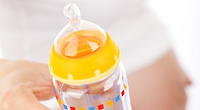EFSA Lowers TDI for BPA by 20,000 Times; Most Consumers at Risk

Credit: derneuemann via Pixabay
Dietary exposure to bisphenol A (BPA), a chemical used in food packaging, is a health concern for consumers across all age groups, according to a reevaluation conducted by the European Food Safety Authority (EFSA). The European Commission and national authorities will discuss appropriate regulatory measures to follow up on EFSA’s advice.
BPA is a chemical substance used in combination with other chemicals to manufacture certain plastics and resins. In an extensive assessment of available scientific evidence, and after input from a public consultation, EFSA’s experts identified potentially harmful health effects of BPA on the immune system.
BPA is used for example in polycarbonate plastic, a transparent and rigid type of plastic used to make water dispensers, food storage containers, and reusable beverage bottles. The substance is also used to produce epoxy resins found in protective coatings and linings for food and beverage cans and vats.
Because chemicals such as BPA used in food containers can migrate into the food and drinks they come in contact with, EFSA’s scientists regularly review their safety. EFSA has examined the safety of BPA in great detail over the years since the agency’s first full risk assessment of the substance in 2006.
For the present reevaluation, EFSA scientists analyzed a large quantity of scientific publications, including over 800 new studies published since January 2013. The findings revealed important uncertainties about BPA’s toxicity.
Specifically, EFSA observed an increase in the percentage of a type of white blood cell called “T helper” in the spleen associated with BPA exposure. T helpers play a key role in humans’ cellular immune mechanisms, and an increase as observed in relevant studies could lead to the development of allergic lung inflammation and autoimmune disorders. EFSA also took into account other potentially harmful health effects of BPA on the reproductive, developmental, and metabolic systems as identified in the risk assessment.
To assess the large number of studies on BPA exposure published since 2013, which was the cut-off point for EFSA’s previous assessment conducted in 2015, EFSA developed a protocol for selecting and appraising all the evidence with the input of stakeholders and EU Member State authorities. The present findings are the result of an intense evaluation process that lasted several years and was finalized using input gathered from a two-month public consultation launched in December 2021.
Compared to the 2015 assessment, EFSA significantly lowered the tolerable daily intake (TDI) for BPA, the amount that can be ingested daily over a lifetime without presenting an appreciable health risk. In 2015, EFSA experts set a temporary TDI due to uncertainties in the evidence, highlighting the need for additional data on the toxicological effects of BPA. The present reevaluation addressed most of the gaps that existed in 2015, and remaining uncertainties were taken into account when setting the new TDI.
EFSA scientists established a TDI of 0.2 nanograms (0.2 billionths of a gram) per kilogram of body weight per day, replacing the previous temporary level of 4 micrograms (4 millionths of a gram) per kilogram of body weight per day. The newly established TDI is around 20,000 times lower than the old TDI.
By comparing the new TDI with estimates of dietary exposure to BPA, EFSA experts concluded that consumers with both average and high exposure to BPA in all age groups exceeded the new TDI, indicating health concerns.
Although EFSA used the exposure estimates from their assessment in 2015, the agency acknowledges that restrictions brought in by EU legislators after 2015 on some uses of the substance may have reduced dietary intake, meaning that the scenario described in the reevaluation is conservative.
EFSA also notes that several variables can influence the overall health risk for an individual regarding BPA exposure, including other stressors on the human body, genetics, and nutrition.
As well as consulting on the draft scientific assessment, EFSA consulted publicly in 2017 on the protocol describing the proposed methodology for reevaluation. EFSA scientists also discussed the methodology and findings with other scientific bodies to clarify or resolve differences that emerged, such as the use of “intermediate endpoints,” which are early signals that indicate the potential development of adverse health effects. In this context, EFSA published joint reports summarizing discussions with the European Medicines Agency (EMA) and the German Federal Institute for Risk Assessment (BfR).
Regarding next steps, EU decision-makers, namely the European Commission and Member State representatives, are responsible for setting limits on the amount of a chemical that may migrate from food packaging into food. EFSA’s scientific advice on BPA will inform discussions among EU lawmakers on the appropriate regulatory measures to take to protect consumers.Update, February 12, 2024: The European Commission has launched a public consultation on a draft regulation that would impose a ban on the use of BPA in food contact materials, including plastic and coated packaging, in light of EFSA's concerns.
Looking for a reprint of this article?
From high-res PDFs to custom plaques, order your copy today!





